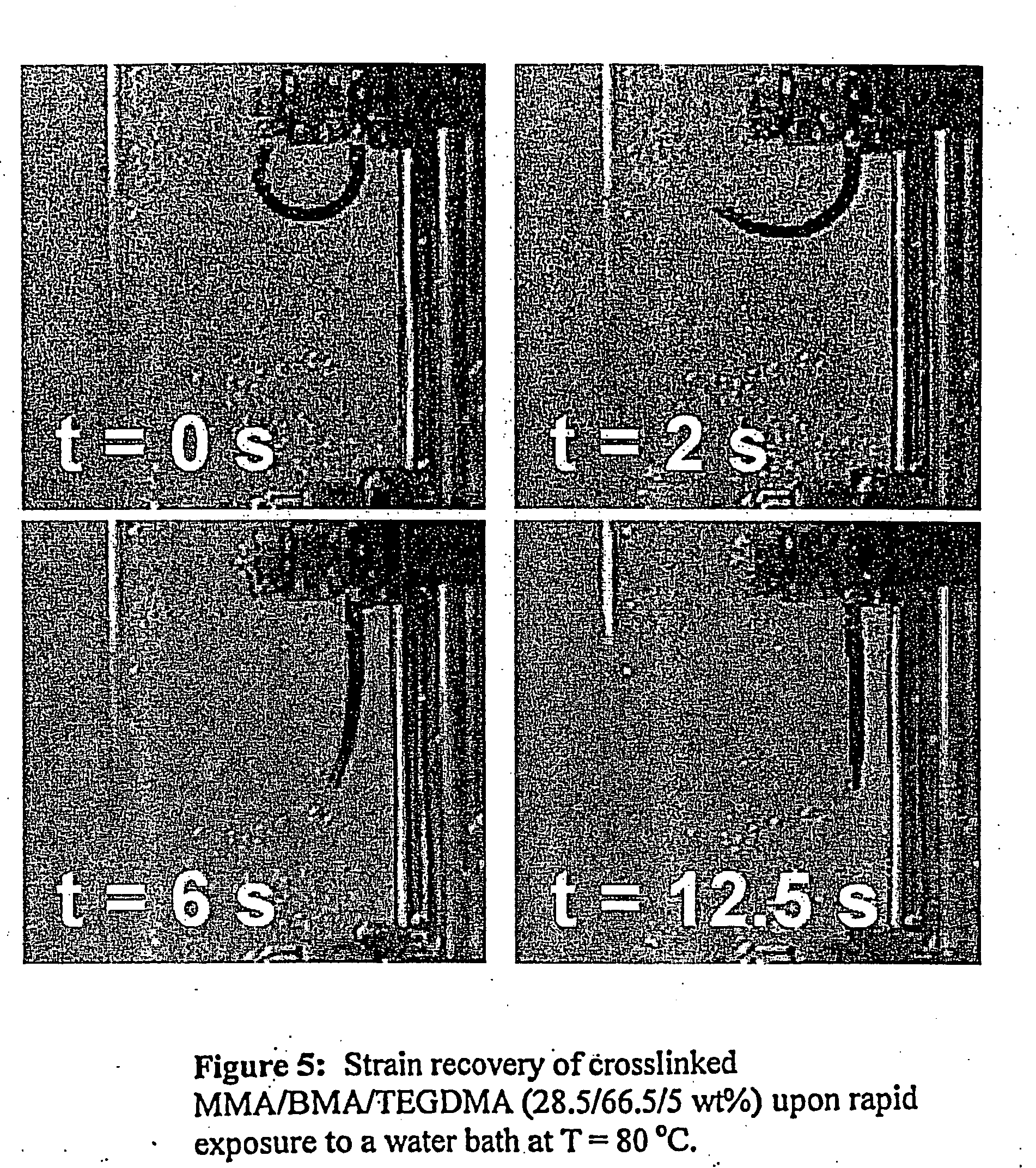Castable shape memory polymers
a memory polymer and shape technology, applied in the direction of catheter, etc., can solve the problems of stress and strain being absorbed by the soft segment, limited use of these polymers, and limited processing speed, etc., and achieve good shape memory
- Summary
- Abstract
- Description
- Claims
- Application Information
AI Technical Summary
Benefits of technology
Problems solved by technology
Method used
Image
Examples
example 1
Synthesis of the POSS-Containing Castable Shape Memory Polymers
[0055] Materials: methacrylisobutyl-POSS (MA0702®, Hybrid Plastics, Inc.) was used as received; methyl methacrylate, butyl methacrylate, tetraethylene glycol dimethylacrylate, and AIBN were purchased from Aldrich and purified as aforementioned.
[0056] Polymerization procedures: The materials MA0702, MMA, BMA, TEGDMA, and AIBN were first mixed in a small vial to obtain a clear miscible solution. The clear (solvent-free) solution was then preheated to a temperature of 65° C. for 30 minutes to yield a clear viscous liquid. The liquid was cooled down to room temperature and injected between two glass slides provided with a seal and spacers. This step was facilitated by the 65° C. / 30 minute preheat which yielded a manageable viscosity. The sealed system was then transferred to an oven preheated to a temperature of 40° C. which was maintained for 48 hours, then increased to 65˜80° C. for ‘another 24 hours, and finally increas...
example 2
Combined UV-Thermal Polymerization
[0058] Materials are the same as aforementioned and were used in the amounts which follow: 30% MMA, 70% BMA, 5% TEGDMA based on the total amount of monomers, and 0.3% AIBN as initiator.
[0059] The materials were first mixed to make a homogenous clear solution and then injected between two glass slides, one glass slide preferably being quartz, and heated to 40° C.; a UV lamp with a wavelength of 365 nm was used to illuminate the reactive mixture for 90 minutes until it solidified. The preparation was moved to an oven maintained at 100 to 120° C. for 24 hrs to have all the residual monomers polymerized.
[0060] The resultant molding showed similar thermomechanical properties as compared to thermally cured moldings, but with an advantage of demolding after partial solidification, thermomechanical forming to a complex 3D shape, and cure completion.
[0061] The process was repeated but without UV illumination at 40° C. for 24 hrs and the mixture still kep...
PUM
| Property | Measurement | Unit |
|---|---|---|
| Fraction | aaaaa | aaaaa |
| Fraction | aaaaa | aaaaa |
| Fraction | aaaaa | aaaaa |
Abstract
Description
Claims
Application Information
 Login to View More
Login to View More - R&D
- Intellectual Property
- Life Sciences
- Materials
- Tech Scout
- Unparalleled Data Quality
- Higher Quality Content
- 60% Fewer Hallucinations
Browse by: Latest US Patents, China's latest patents, Technical Efficacy Thesaurus, Application Domain, Technology Topic, Popular Technical Reports.
© 2025 PatSnap. All rights reserved.Legal|Privacy policy|Modern Slavery Act Transparency Statement|Sitemap|About US| Contact US: help@patsnap.com



